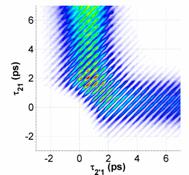
ACS PRF | ACS
All e-Annual Reports

43121-AC6
Electronically Resonant Coherent Multidimensional Vibrational Spectroscopy
Our group has been developing a new family of coherent multidimensional spectroscopies (CMDS) using mixed frequency/time domain methods. Here, the excitation pulses are long enough that one has adequate spectral resolution to excite particular quantum states but short enough that one can monitor the dynamics of these states. We have discovered that this approach allows one to directly observe coherence transfer where excitation of one quantum state creates a quantum entanglement that evolves in time because of interaction with the thermal bath until it is transformed into an entanglement with a new quantum Our experiments use four wave mixing (FWM) where 3 excitation pulses create a 4th output pulse. We obtain the spectral information in the frequency domain by scanning the 3 excitation frequencies while monitoring the output intensity with a monochromator at ωm. Multiple resonances create multiplicative enhancements and cross-peaks if the resonant states are coupled. Dynamics are measured in the time domain by scanning the time delays between the three excitation pulses or measuring the output coherence relaxation. The output frequency is usually defined by the particular Fourier component of the three excitation frequencies and so the monochromator is normally tuned to monitor that frequency. However, if coherence transfer occurs, the output frequency is changed and one observes The output signal resulting from coherence transfer is usually weak compared to the purely radiative output signals that don't involve coherence transfer. We discovered that one can use a phase matching geometry where the purely radiative output coherence involves a forbidden transition. In the previous diagram, the purely radiative output is a coherence between the overtone of state a and the fundamental of state b. The coherence transfer peak is therefore quite bright relative to the purely radiative peak. If one changes the delay times between the three excitation lasers, one obtains the complex modulation pattern shown on the accompanying figure. The pattern occurs because of the interference between the multiple pathways that create the same output coherence. The first figure identifies these pathways. We have also found that one can use coherence transfer to perform coherent multidimensional spectroscopy with a single laser frequency. Here, all the excitation frequencies are tuned to the same transition but new frequencies appear at the output because of coherence transfer. An example coherence transfer pathway for this experiment is The modulations are a signature of the coherence transfer and the narrow band excitation identifies all of the states involved in the transfer. Coherence transfer offers a new opportunity to examine coupling between two different quantum states, particularly the coupling that leads to coherent electron transfer.  state. The new quantum state is coupled to the previous one through inter- or intra-molecular interactions so one can perform multidimensional spectroscopy by taking advantage of coherence transfer to identify the coupled quantum states.
state. The new quantum state is coupled to the previous one through inter- or intra-molecular interactions so one can perform multidimensional spectroscopy by taking advantage of coherence transfer to identify the coupled quantum states.  new frequencies. The first diagram shows how the coherences (the two letters label the states entangled in the coherence) evolve because of interaction with the excitation fields (solid black arrows) because of coherence transfer (dashed red arrows). The red boxes indicate output coherences that involve coherence transfer and the black box indicates a purely radiative process.
new frequencies. The first diagram shows how the coherences (the two letters label the states entangled in the coherence) evolve because of interaction with the excitation fields (solid black arrows) because of coherence transfer (dashed red arrows). The red boxes indicate output coherences that involve coherence transfer and the black box indicates a purely radiative process. ![]()
 field caused the same transition and it was coherence transfer that created a different quantum state that radiated an output signal at a different frequency. There's a similar multiplicity of pathways with different time orderings for each of the events and they all interfere to create the complex modulation period shown in the last figure.
field caused the same transition and it was coherence transfer that created a different quantum state that radiated an output signal at a different frequency. There's a similar multiplicity of pathways with different time orderings for each of the events and they all interfere to create the complex modulation period shown in the last figure.